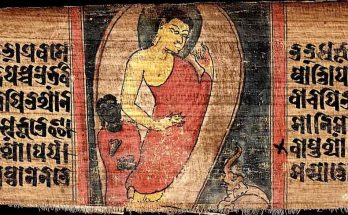Tarpan, the traditional culture of Hindu religion is celebrated today in spite of Corona Fear. Image Courtesy – Bigumbrella
This year is different from the previous years due to the pandemic for coronavirus infection that has covered the entire world. It also disrupted the normal life of people. The traditional culture tarpan of Hindu religion is celebrated in India today in spite of Corona Fear.
Goddess Durga is returning to earth after ending a year of waiting. Durga Puja will be celebrated after one month from this day of Mahalaya this year. A bit different from the previous years because a month-long ominous period will be there from the end of this day.
The fear of infection due to coronavirus is also hanging like an axe on everyone’s head. In spite of that, the traditional culture ‘Tarpan’ is being celebrated today according to Hindu religious activities. Usually ‘Tarpan’ started from the very early morning, and it continued till the ‘Amavasya’ tithi exists.
Tarpan is a very special traditional rite according to Hindu mythology. Many people take part in ‘Tarpan’ at the end of ‘Pitripaksha’ and the starting of ‘Devipaksh’.
Read: Mahalaya – the stepping stone of Durga Puja Ceremony in India
What does Hindu mythology say?
According to Hindu belief, death rituals such as ghost work (shraddha), tarpana, etc. are performed on the father’s side, these rituals are not favourable to auspicious works. In South and West India, this ritual begins on the date of the next full moon (Bhadra Purnima) of the Ganesha festival and ends on the Sarva Pitra Amabasya or, on the Mahalaya Amabasya or, on the Mahalaya Day. In northern India, the Krishna Paksha of the month of Ashwin is called the patriarch instead of Bhadra.
The two new moons made the month Ashwin an inauspicious month this year. This month is called a ‘Mala-Mash’. So, the spiritual fortnight of the Goddess’ awakening will start on October 17, 2020 this year, with the beginning of the lunar month ‘Kartik’.
What does the Purana say?
According to the Hindu Puranas, the ancestors up to three generations of a living person stay in ‘Pitrulok’ or ‘Fatherland’. Yama, the god of death and the ruler of the ‘Fatherland’, takes the soul of the newly dead person from the mortal earth to ‘Pitrulok’ or ‘Fatherland’.
When one of the next generation dies, one of the ancestors of the previous generation leaves ‘Pitrulok’ or, ‘Fatherland’ and goes to heaven and merges to the God. In this process he/she ascends above the ‘Shraddh’ (funeral) ritual. For this reason, only the previous three generations of the living person are offered ‘Shraddh’ ritual.
Some ingredients are important in Tarpan
The two ingredients that are important in Tarpan are ‘Kush’ and ‘Black Sesame’. First soak the six Kush in water and when it becomes soft. Make a ring around the ring finger with 3 Kush and wear the ring in that finger of the right hand. Make another ring also and wear it in the left hand ring finger. If Kush and Black Sesame are not available, you can perform ‘Tarpan’ with just water.
Every person wants their ancestors to go to the best place out of the mortal world and be happy after their death. According to the Hindu religion, the happiness and prosperity of the family in worldly, materialistic life, is maintained with the happiness of the ancestors. Therefore, in every year from Bhadrapada Poornima to Ashwin Amavasya, ‘Shraddh’, ‘Tarpan’ and ‘Pindadan’ for the ancestors are performed in India.





